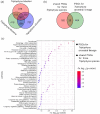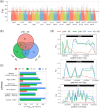Chromosomal genome of Triplophysa bleekeri provides insights into its evolution and environmental adaptation
- PMID: 33231676
- PMCID: PMC7684707
- DOI: 10.1093/gigascience/giaa132
Chromosomal genome of Triplophysa bleekeri provides insights into its evolution and environmental adaptation
Abstract
Background: Intense stresses caused by high-altitude environments may result in noticeable genetic adaptions in native species. Studies of genetic adaptations to high elevations have been largely limited to terrestrial animals. How fish adapt to high-elevation environments is largely unknown. Triplophysa bleekeri, an endemic fish inhabiting high-altitude regions, is an excellent model to investigate the genetic mechanisms of adaptation to the local environment. Here, we assembled a chromosomal genome sequence of T. bleekeri, with a size of ∼628 Mb (contig and scaffold N50 of 3.1 and 22.9 Mb, respectively). We investigated the origin and environmental adaptation of T. bleekeri based on 21,198 protein-coding genes in the genome.
Results: Compared with fish species living at low altitudes, gene families associated with lipid metabolism and immune response were significantly expanded in the T. bleekeri genome. Genes involved in DNA repair exhibit positive selection for T. bleekeri, Triplophysa siluroides, and Triplophysa tibetana, indicating that adaptive convergence in Triplophysa species occurred at the positively selected genes. We also analyzed whole-genome variants among samples from 3 populations. The results showed that populations separated by geological and artificial barriers exhibited obvious differences in genetic structures, indicating that gene flow is restricted between populations.
Conclusions: These results will help us expand our understanding of environmental adaptation and genetic diversity of T. bleekeri and provide valuable genetic resources for future studies on the evolution and conservation of high-altitude fish species such as T. bleekeri.
Keywords: Triplophysa bleekeri; genetic adaptation; genome; population genomics.
© The Author(s) 2020. Published by Oxford University Press GigaScience.
Conflict of interest statement
The authors declare that they have no competing interests.
Figures






Similar articles
-
Evidence for Adaptation to the Tibetan Plateau Inferred from Tibetan Loach Transcriptomes.Genome Biol Evol. 2015 Oct 9;7(11):2970-82. doi: 10.1093/gbe/evv192. Genome Biol Evol. 2015. PMID: 26454018 Free PMC article.
-
Chromosome-level genome assembly of Triplophysa tibetana, a fish adapted to the harsh high-altitude environment of the Tibetan Plateau.Mol Ecol Resour. 2019 Jul;19(4):1027-1036. doi: 10.1111/1755-0998.13021. Epub 2019 May 14. Mol Ecol Resour. 2019. PMID: 30977968
-
Complete mitochondrial genome of Triplophysa bleekeri (Cypriniformes: Balitoridae: Nemacheilinae), and analysis of mitochondrial genetic variability among Triplophysa species.Mitochondrial DNA A DNA Mapp Seq Anal. 2016 Nov;27(6):4132-4133. doi: 10.3109/19401736.2014.1003878. Epub 2015 Jan 20. Mitochondrial DNA A DNA Mapp Seq Anal. 2016. PMID: 25600735
-
The Chromosome-Level Genome of Triplophysa dalaica (Cypriniformes: Cobitidae) Provides Insights into Its Survival in Extremely Alkaline Environment.Genome Biol Evol. 2021 Aug 3;13(8):evab153. doi: 10.1093/gbe/evab153. Genome Biol Evol. 2021. PMID: 34185063 Free PMC article.
-
[Adaptive Regulation of Glucose Metabolism and Diseases in High-Altitude Areas].Sichuan Da Xue Xue Bao Yi Xue Ban. 2024 Nov 20;55(6):1460-1468. doi: 10.12182/20241160604. Sichuan Da Xue Xue Bao Yi Xue Ban. 2024. PMID: 39990855 Free PMC article. Review. Chinese.
Cited by
-
A chromosome-scale reference genome assembly for Triplophysa lixianensis.Sci Data. 2024 Dec 19;11(1):1404. doi: 10.1038/s41597-024-04268-y. Sci Data. 2024. PMID: 39702774 Free PMC article.
-
Salmonidae Genome: Features, Evolutionary and Phylogenetic Characteristics.Genes (Basel). 2022 Nov 27;13(12):2221. doi: 10.3390/genes13122221. Genes (Basel). 2022. PMID: 36553488 Free PMC article. Review.
-
The complete mitochondrial genome of Triplophysa grahami Regan 1906 (Cypriniformes: Nemacheilidae) and phylogenetic analysis.Mitochondrial DNA B Resour. 2024 Sep 4;9(9):1190-1195. doi: 10.1080/23802359.2024.2399926. eCollection 2024. Mitochondrial DNA B Resour. 2024. PMID: 39247499 Free PMC article.
-
Genome and population evolution and environmental adaptation of Glyptosternon maculatum on the Qinghai-Tibet Plateau.Zool Res. 2021 Jul 18;42(4):502-513. doi: 10.24272/j.issn.2095-8137.2021.096. Zool Res. 2021. PMID: 34254744 Free PMC article.
-
Chromosome-Level Genome Assembly of Discogobio brachyphysallidos (Teleostei, Cyprinidae) and Population Genomics of the D. brachyphysallidos Complex: Impacts of Geological and Climate Changes on Species Evolution in Southwest China.Int J Mol Sci. 2024 Dec 16;25(24):13462. doi: 10.3390/ijms252413462. Int J Mol Sci. 2024. PMID: 39769226 Free PMC article.
References
-
- Myers N, Mittermeier RA, Mittermeier CG, et al. Biodiversity hotspots for conservation priorities. Nature. 2000;403(6772):853. - PubMed
-
- Zhao Z, Li S. Extinction vs. rapid radiation: the juxtaposed evolutionary histories of coelotine spiders support the Eocene–Oligocene orogenesis of the Tibetan Plateau. Syst Biol. 2017;66(6):988–1006. - PubMed
-
- Beall CM. Adaptation to high altitude: phenotypes and genotypes. Annu Rev Anthropol. 2014;43:251–72.
-
- Monge C, Leonvelarde F. Physiological adaptation to high altitude: oxygen transport in mammals and birds. Physiol Rev. 1991;71(4):1135–72. - PubMed
-
- Wu T, Kayser B. High altitude adaptation in Tibetans. High Alt Med Biol. 2006;7(3):193–208. - PubMed
Publication types
MeSH terms
LinkOut - more resources
Full Text Sources
Miscellaneous

